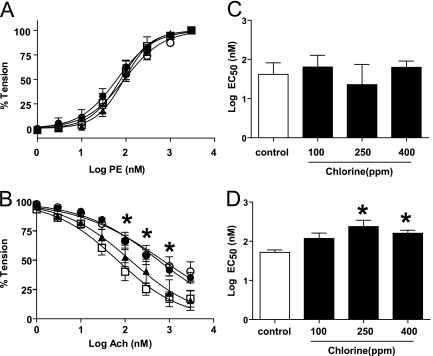Figure 1.
Chlorine gas (Cl2) exposure inhibits aortic vasodilation in response to acetylcholine. Rats were exposed to air (open squares) or Cl2 (400 ppm, 30 min). Aorta were isolated at 6 (closed triangles), 24 (closed circles), or 48 hours (open circles) thereafter, and vasoconstriction and vasodilation responses to phenylephrine (PE) (A) or acetycholine (Ach) (B), respectively, were determined. Data are means ± SEM for cumulative dose-dependent changes in tension. *P < 0.05 by two-way repeated measures ANOVA with Bonferroni post-test for 24 and 48 hours after Cl2 exposure relative to control (n = 3–12). (C and D) EC50 values for PE-dependent vasoconstriction and Ach-dependent vasodilation, respectively, in aorta isolated from rats 24 hours after exposure to different doses of Cl2 (0–400 ppm) for 30 minutes. Data show mean ± SEM. *P < 0.05 by one-way ANOVA with Bonferroni post-test relative to control (n = 5–11).

